CAS News
The New Estate Tax Rules and Your Estate Plan

Looking ahead
For 2013 and later years, the 2012 Tax Act permanently extended the $5 million (as indexed for inflation) gift and estate tax exemption and GST tax exemption, and portability of the gift and estate tax exemption, but it also increased the top gift, estate, and GST tax rate to 40%.
Gifts
The large exemptions may make it easier than ever to make large gifts, but they may also reduce the need to make large gifts in order to reduce the gross estate for estate tax purposes.
The Tax Relief, Unemployment Insurance Reauthorization, and Job Creation Act of 2010 (the 2010 Tax Act) included new gift, estate, and generation-skipping transfer (GST) tax provisions. The 2010 Tax Act provided that in 2011 and 2012, the gift and estate tax exemption was $5 million (indexed for inflation in 2012), the GST tax exemption was also $5 million (indexed for inflation in 2012), and the maximum rate for both taxes was 35%. New to estate tax law was gift and estate tax exemption portability: generally, any gift and estate tax exemption left unused by a deceased spouse could be transferred to the surviving spouse in 2011 and 2012. The GST tax exemption, however, is not portable. Starting in 2013, the American Taxpayer Relief Act of 2012 (the 2012 Tax Act) permanently extended the $5 million (as indexed for inflation, and thus $5,430,000 in 2015, $5,340,000 in 2014) exemptions and portability of the gift and estate tax exemption, but also increased the top gift, estate, and GST tax rate to 40%. You should understand how these new rules may affect your estate plan.
Exemption portability
Under prior law, the gift and estate tax exemption was effectively “use it or lose it.” In order to fully utilize their respective exemptions, married couples often implemented a bypass plan: they divided assets between a marital trust and a credit shelter, or bypass, trust (this is often referred to as an A/B trust plan). Under the 2010 and 2012 Tax Acts, the estate of a deceased spouse can transfer to the surviving spouse any portion of the exemption it does not use (this portion is referred to as the deceased spousal unused exclusion amount, or DSUEA). The surviving spouse’s exemption, then, is increased by the DSUEA, which the surviving spouse can use for lifetime gifts or transfers at death.
Example: At the time of Henry’s death in 2011, he had made $1 million in taxable gifts and had an estate of $2 million. The DSUEA available to his surviving spouse, Linda, is $2 million ($5 million – ($1 million + $2 million)). This $2 million can be added to Linda’s own exemption for a total of $7,430,000 ($5,430,000 + $2 million), assuming Linda dies in 2015.
The portability of the exemption coupled with an increase in the exemption amount to $5,430,000 per taxpayer allows a married couple to pass on up to $10,860,000 gift and estate tax free in 2015. Though this seems to negate the usefulness of A/B trust planning, there are still many reasons to consider using A/B trusts.
•The assets of the surviving spouse, including those inherited from the deceased spouse, may appreciate in value at a rate greater than the rate at which the exemption amount increases. This may cause assets in the surviving spouse’s estate to exceed that spouse’s available exemption. On the other hand, appreciation of assets placed in a credit shelter trust will avoid estate tax at the death of the surviving spouse.
•The distribution of assets placed in the credit shelter trust can be controlled. Since the trust is irrevocable, your plan of distribution to particular beneficiaries cannot be altered by your surviving spouse. Leaving your entire estate directly to your surviving spouse would leave the ultimate distribution of those assets to his or her discretion.
•A credit shelter trust may also protect trust assets from the claims of any creditors of your surviving spouse and the trust beneficiaries. You can also include a spendthrift provision to limit your surviving spouse’s access to trust assets, thus preserving their value for the trust beneficiaries.
A/B trust plans with formula clauses
If you currently have an A/B trust plan, it may no longer carry out your intended wishes because of the increased exemption amount. Many of these plans use a formula clause that transfers to the credit shelter trust an amount equal to the most that can pass free from estate tax, with the remainder passing to the marital trust for the benefit of the spouse. For example, say a spouse died in 2003 with an estate worth $5,430,000 and an estate tax exemption of $1 million. The full exemption amount, or $1 million, would have been transferred to the credit shelter trust and $4,430,000 would have passed to the marital trust. Under the same facts in 2015, since the exemption has increased, the entire $5,430,000 estate will transfer to the credit shelter trust, to which the surviving spouse may have little or no access. Review your estate plan carefully with an estate planning professional to be sure your intentions will be carried out under the new laws.
Wealth transfer strategies through gifting
Because of the larger exemptions and lower tax rates, there may be unprecedented opportunities for gifting.
By making gifts up to the exemption amount, you can significantly reduce the value of your estate without incurring gift tax. In addition, any future appreciation on the gifted assets will escape taxation. Assets with the most potential to increase in value, such as real estate (e.g., a vacation home), expensive art, furniture, jewelry, and closely held business interests, offer the best tax savings opportunity.
Gifting may be done in several different forms. These include direct gifts to individuals, gifts made in trust (e.g., grantor retained annuity trusts and qualified personal residence trusts), and intra-family loans. Currently, you can also employ techniques that leverage the high exemptions to potentially provide an even greater tax benefit (for example, creating a family limited partnership may also provide valuation discounts for tax purposes).
For high-net-worth married couples, gifting to an irrevocable life insurance trust (ILIT) designed as a dynasty trust can reduce estate size while providing a substantial gift for multiple generations (depending on how long a trust can last under the laws of your particular state). The value of the gift may be increased (leveraged) by the purchase of second-to-die life insurance within the trust. Further, the larger exemptions enable you to increase, gift tax free, the premiums paid for life insurance policies that are owned by the ILIT or other family members. Premium payments on such policies are taxable gifts, so these premium payments are often limited to avoid incurring gift tax. This in turn restricts the amount of life insurance that can be purchased. But the increased exemptions provide the opportunity to make significantly greater gifts of premium payments, which can be used to buy a larger life insurance policy.
Before implementing a gifting plan, however, there are a few issues you should consider.
•Can you afford to make the gift in the first place (you may need those assets and the related cash flow in the future)?
•Do you anticipate that your estate will be subject to estate taxes at your death?
•Is minimizing estate taxes more important to you than retaining control over the asset?
•Do you have concerns about gifting large amounts to your heirs (i.e., is the recipient competent to manage the asset)?
•Does the transfer tax savings outweigh the potential capital gains tax the recipient may incur if the asset is later sold? The recipient of the gift gets a carryover basis (i.e., your tax basis) for income tax purposes. On the other hand, property left to an individual as a result of death will generally receive a step-up in cost basis to fair market value at date of death, resulting in potentially less income tax to pay when such an asset is ultimately sold.
Caution: The amount of gift tax exemption you used in the past will reduce the $5,430,000 available to you in 2015. For example, a person who used $1 million of his or her exemption in 2012, will be able to make additional gifts totaling $4,430,000 during 2015 free from gift tax.
Tip: In addition to this opportunity to transfer a significant amount of wealth tax free, it’s important to remember that you can still take advantage of the $14,000 per person per year annual gift tax exclusion for 2014 and 2015. Also, gifts of tuition payments and payment of medical expenses (if paid directly to the institutions) are still tax free and can be made at any time.
Prepared by Broadridge Investor Communication Solutions, Inc. Copyright 2014.
IRA and Retirement Plan Limits for 2015
Market Wrap at Casa Larga Vineyards & Winery
 Our New York office welcomed 179 clients and guests to Casa Larga Vineyards & Winery in Perinton, NY for the annual Market Wrap on Wednesday, October 29th. Upon their arrival, clients enjoyed tastings of some of the vineyards favorites before convening in the stateroom.
Our New York office welcomed 179 clients and guests to Casa Larga Vineyards & Winery in Perinton, NY for the annual Market Wrap on Wednesday, October 29th. Upon their arrival, clients enjoyed tastings of some of the vineyards favorites before convening in the stateroom.
Situated on the crest of rolling hills, Casa Larga boasts a backdrop of spectacular fall foliage. On this clear fall evening, the breathtaking views were visible through the picturesque windows throughout the establishment.
As the sun set, Ray Ciccarelli took center stage and delivered his economic overview. He outlined the strengths and weaknesses of the U.S. economy as well as areas of potential opportunity and risk in the foreseeable future.
Following Ray, Carol Girvin articulated the upcoming increases to retirement funding limits slated for 2015 as well as some nuances of the Long-Term Care marketplace.
Following the program, the clients were treated to a spectacular dessert buffet presented by Rochester-based Sweet Sammie Jane’s. The sweets were decadent and the clients enjoyed every morsel!
Elephant Fest 2014
 Ciccarelli Advisory Services is proud to support the Alzheimer’s Support Network and all they do in our community to help families that have been affected by Alzheimer’s. If you would like to support The Alzheimer’s Support Network, too, we encourage you to have a “fun” day at the Zoo to support their annual Elephant Fest. For more information, contact Barbara Kronenfeld at 661-304-5240.
Ciccarelli Advisory Services is proud to support the Alzheimer’s Support Network and all they do in our community to help families that have been affected by Alzheimer’s. If you would like to support The Alzheimer’s Support Network, too, we encourage you to have a “fun” day at the Zoo to support their annual Elephant Fest. For more information, contact Barbara Kronenfeld at 661-304-5240.
CAS Advisors Attend ConnectED 2014 Conference
 Financial advisors, Kim Ciccarelli Kantor, CFP®, CAP™, Raymond F. Ciccarelli, Paul F. Ciccarelli, CFP®, ChFC®, CLU® & Anthony J. Curatolo recently attended the 2014 AIG Advisor Group ConnectED conference. The annual conference was the largest to date, with more than 3,400 attendees gathering in Nashville, Tennessee, for the event. Financial advisors with FSC Securities Corp, Royal Alliance, SagePoint Financial and Woodbury Financial, the four broker-dealers of AIG Advisor Group, were in attendance.
Financial advisors, Kim Ciccarelli Kantor, CFP®, CAP™, Raymond F. Ciccarelli, Paul F. Ciccarelli, CFP®, ChFC®, CLU® & Anthony J. Curatolo recently attended the 2014 AIG Advisor Group ConnectED conference. The annual conference was the largest to date, with more than 3,400 attendees gathering in Nashville, Tennessee, for the event. Financial advisors with FSC Securities Corp, Royal Alliance, SagePoint Financial and Woodbury Financial, the four broker-dealers of AIG Advisor Group, were in attendance.
“ConnectED 2014 brought together some of the top advisors from across the nation to share best practices and creative ideas for partnering with clients to help them achieve strong financial futures,” said Erica McGinnis, President and CEO, AIG Advisor Group. “With presentations from a variety of key leaders and hundreds of educational breakout sessions, advisors left the conference with new knowledge, new skills and new opportunities for success.”
The three-day conference included general sessions with former Secretary of State Dr. Condoleezza Rice, Cam Marston – a well-respected expert on generational insights, and Pulitzer Prize winning author Dave McCullough. Advisors could also attend breakout sessions on topics ranging from global investing trends, social security reform, technology solutions for financial planning and more.
“ConnectED 2014 was a fantastic conference,” said Kim Ciccarelli Kantor. “From the incredible speakers to the interesting breakout sessions and many networking opportunities, I learned so much that can benefit my clients and my practice directly. This conference is a powerful learning opportunity, and one of the reasons I am so glad to be part of AIG Advisor Group.”
Volatility Is Up. So What?
Professional investors know something that most people find impossible to believe: that the threat of scary ups and downs in the markets is by far the best friend of the long-term investor. Why? Because over the long term, stocks have provided returns far higher than bonds or cash. If it weren’t for the occasional dizzying gyrations, any rational investor would put his or her money where the highest returns have been. Right?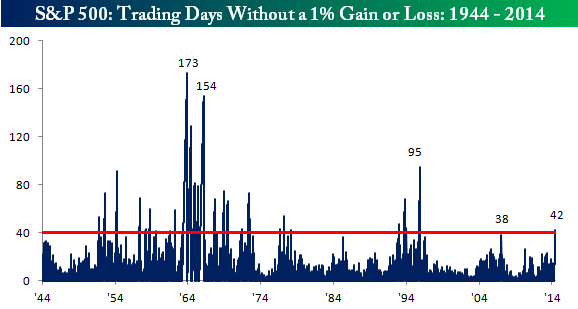
This appears to be one of those times–a time when non-professional investors are reminded of the reasons why they have this lingering fear of the stock market. Since the end of September, the S&P 500 index has done something regularly that it normally does infrequently: moved more than a full percent up or down in a single day. Consider the recent pattern this month:
- Oct. 1 -1.3%
- Oct. 4 +0.05%
- Oct. 5 +1.1%
- Oct. 6 -0.2%
- Oct. 7 -1.5%
- Oct. 8 +1.8%
- Oct. 9 -2.1%
- Oct. 10 -1.1%
- Oct. 13 -1.65%
Contrast this to the calm before the storm: earlier this year, the markets experienced 42 consecutive days without a single 1% price move, and the accompanying chart shows that this is far from the record.
The question we should be asking ourselves is: why are we paying such close attention to daily market movements? Why are we allowing ourselves to fall for the trap of getting anxious over short-term swings in stock prices?
The second chart shows the growth of a dollar invested in the S&P 500 at the beginning of 1950, with dividends reinvested, compared with a variety of alternative investments which have not provided the same returns. (Note that small cap stocks, which are more volatile, have done even better.) The chart also shows all the scary headlines that the markets managed to sail through on the way to their current levels–all of which are scarier than the things we’re reading about today.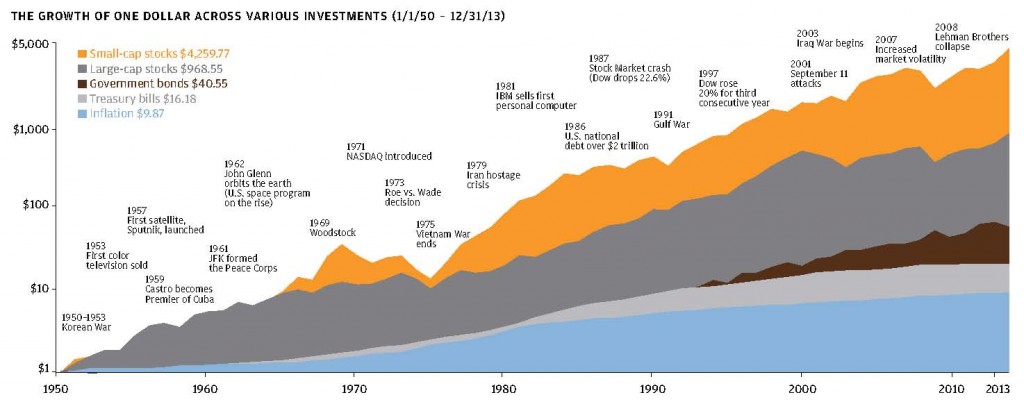
This is not to say that the markets won’t go lower in the coming days, weeks or months; in fact, we are still awaiting that correction of at least 10% which the markets delivery with some regularity on their way to new highs, which has been long-delayed in this current bull market. The thing to remember is that the daily price of your stock holdings are determined by mood swings of skittish investors whose fears are stoked by pundits and commentators in the press, who know that the best way to get and hold your attention is to scare the heck out of you. What they don’t say, because it’s boring, is that the value of your stock holdings are determined by the effectiveness of millions of workers who go to work every day in offices and factories, farms, warehouses, power plants and research facilities, who slowly, incrementally, with their daily labor, build up the value of the businesses they work for.
The last time we checked, that incremental progress hasn’t stopped. The economy is still growing. You won’t get a daily report on the value of the stocks you own; only the daily, changing opinions of skittish investors. But if you take a second look at the growth of an investment in stocks over the long-term, you get a better idea of how that value is built over time, no matter what the markets will do tomorrow.
Sources: http://www.bespokeinvest.com/thinkbig/2014/6/17/1-moves.html
Economic Update – Third Quarter 2014
The third quarter of 2014 was very interesting. The overall results for many investors were positive, but while several diverse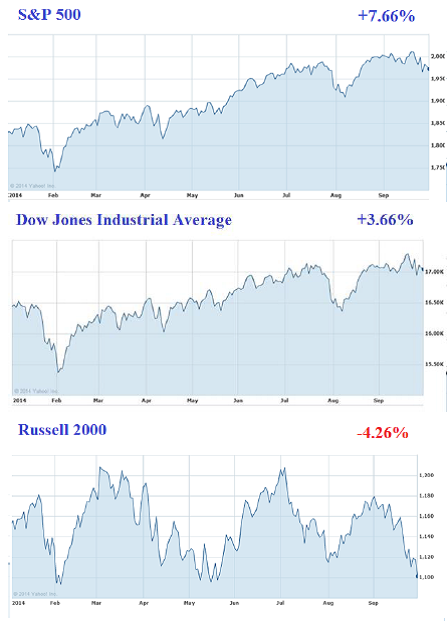 pockets of the market enjoyed gains, other stocks struggled. The S&P 500 and the DJIA (both of which track larger established companies) continued to outperform small stocks and foreign shares. Through Sept 30, 2014 the S&P 500 was up 7.66% and the DJIA was up 3.66%. By comparison, the Russell 2000 Index (which tracks small stocks) is down 4.26% for 2014. (Source: Wall Street Journal)
pockets of the market enjoyed gains, other stocks struggled. The S&P 500 and the DJIA (both of which track larger established companies) continued to outperform small stocks and foreign shares. Through Sept 30, 2014 the S&P 500 was up 7.66% and the DJIA was up 3.66%. By comparison, the Russell 2000 Index (which tracks small stocks) is down 4.26% for 2014. (Source: Wall Street Journal)
Many analysts feel that several U.S. big stocks are still more attractively priced than smaller stocks and that this trend could continue. “Small stocks are victims of their own success,” according to Jack Ablin, Chief Investment officer of BMO Private Bank. “They made a huge move last year and entered into this year overvalued. While there are great small company stocks, small caps in general need to take a back seat to their larger competitors until valuations come back into alignment.” In fact, some portfolio managers are fearful that the small cap underperformance has just begun. (Source: Wall Street Journal 9/29/2014)
Although caution still remains the top priority for most investors, many analysts feel that the bull could stay in charge for the rest of this year and possibly longer. Barron’s surveyed 10 top analysts in September and surprisingly, all of them felt that the upward trend would continue. While several analysts toned down their optimism because of the market’s gains, they still feel that we have not reached the market’s ultimate peak. They feel that rising corporate profits will continue to lead to increases in large cap stock prices. Having said this, they still caution investors about political tensions and interest rates. (Source: Barron’s 9/8/2014)
In a recent Interview, Dirk Hofschire, Senior Vice President of Asset Allocation Research at Fidelity Investments, said, “We continue to have a favorable global backdrop for asset prices. It’s been a Goldilocks environment where things are not too fast, not too slow, not too warm, not too cold. The U.S. economy has still been making progress, jobs are being created, unemployment is coming down and many leading indicators still point up.” (Source: Fidelity.com)
Investors are still keeping a watchful eye on the Fed—its bond buying program is set to end in October and many investors expect the Fed to raise interest rates sometime next year.
Recently, volatility has returned to the market and investors are noticing a “see-saw” effect between the bears (who are convinced stock prices will fall) and the bulls (who rush in during market swings to selectively add to their equity positions). Who is right? Only time will tell!
MONETARY POLICY
Many investors are watching the Federal Reserve very closely and with good reason. The Fed’s September bond purchases were only $15 Billion and in October they are moving towards their pledge to end the Quantitative Easing program of buying bonds. This is leaving many analysts concerned about the upward movement of interest rates. The Fed’s key interest rate target has been pinned at virtually zero since December 2008 (the depth of the financial crisis).
This is not the first time that the Federal Reserve has taken a “whatever it takes” approach to supporting monetary policy. Thirty-five years ago on October 6, 1979, 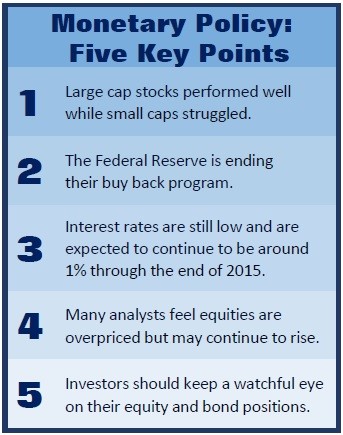 the Federal Reserve, led by Paul Volker, made a revolutionary change in how it handled monetary policy. Faced with double-digit inflation rates, the central bank responded by raising interest rates to 20%. Although this caused other aftershocks, this extreme policy would go on to tame inflation rates. (Source: Barrons 10/6/2014)
the Federal Reserve, led by Paul Volker, made a revolutionary change in how it handled monetary policy. Faced with double-digit inflation rates, the central bank responded by raising interest rates to 20%. Although this caused other aftershocks, this extreme policy would go on to tame inflation rates. (Source: Barrons 10/6/2014)
Monetary policy has had a key impact on the world’s major economies. Investors are rightly concerned about how effective monetary policy can be given the fact that central bankers have cut rates just about as much as they can.
According to Matthew Coffina at Morningstar research, “interest rates have been one of the biggest surprises of the year. Going into 2014, most pundits expected a steady rise in interest rates as the Federal Reserve winds down its purchases of long-term bonds and moves closer to raising short-term rates. Instead, the yield on the 10-year Treasury fell from 3% at the start of the year to a low of 2.34% in mid-August. The 10-year Treasury yield has since recovered to around 2.6%, but it remains below where many market observers had expected.”
Today, as the Fed prepares to wind down its extraordinary Quantitative Easing policy, interest rates are still close to zero. The consensus among analysts is that we are still about a year or so away from the Fed’s first interest rate hike, or tightening of the cycle. The Federal Reserve faces a delicate few months ahead amid internal debates over when to start raising interest rates and how to adjust its public guidance about its likely actions. The Fed and its current leader, Janet Yellen, have been clear in communicating that even when they get to that first tightening, they will probably go pretty slow in raising interest rates.
Many investors are still searching for safe, short-term debt. This demand intensified at the end of the quarter, pushing up bond prices and forcing down yields. The yield on the US Treasury bill on September 2nd reached a negative .01%. (Source: Wall Street Journal 9/24/2014)
During periods of market anxiety, Treasury Bonds can provide a safe harbor for many investors. So what should Bond investors do? Should they sit back and watch the data and refrain from taking any long term positions?
The entire bond market suffered when interest rates rose last year. If the Fed changes rates it could affect shorter dated bonds. Russ Koesterich, Chief Investment Strategist at Blackrock, warns to be careful with even two to five year Treasury bonds. (Source: Barron’s 9/1/2014)
While bonds are an important part of many financial plans, this is a good time to be very watchful of all income-oriented investments. Interest rates have remained at historically low levels for quite some time. Global rates continue to remain exceptionally low and that typically reduces the risk of a swift upward movement in U.S. interest rates.
Recent employment reports painted a brighter picture of the U.S. economy, but they also showed stagnant workers’ wages. Without rising incomes, the Fed seems to be less worried about inflation. That means that even though the jobless rate has hit a level at which the Fed might otherwise consider raising interest rates, it is no longer under the inflation gun when it comes to timing. (Source: Barron’s 10/6/2014)
It is anyone’s guess when the Fed will raise interest rates and by how much. On a positive note, Federal Reserve Chairperson Janet Yellen stated that she sees interest rates continuing around 1% until the end of 2015.
PRICE–TO–EARNINGS RATIO
Price-to-earnings (P/E) ratios are still a key factor in the valuation of equities for many analysts. P/E is a valuation ratio of a company’s current share price (market value) compared to its per-share earnings. For example, if a company is currently trading at $40/share and earnings over the last 12 months were $2/share, the P/E ratio for the stock would be 20 ($40/$2). Generally a high P/E ratio means that investors are anticipating higher growth in the future.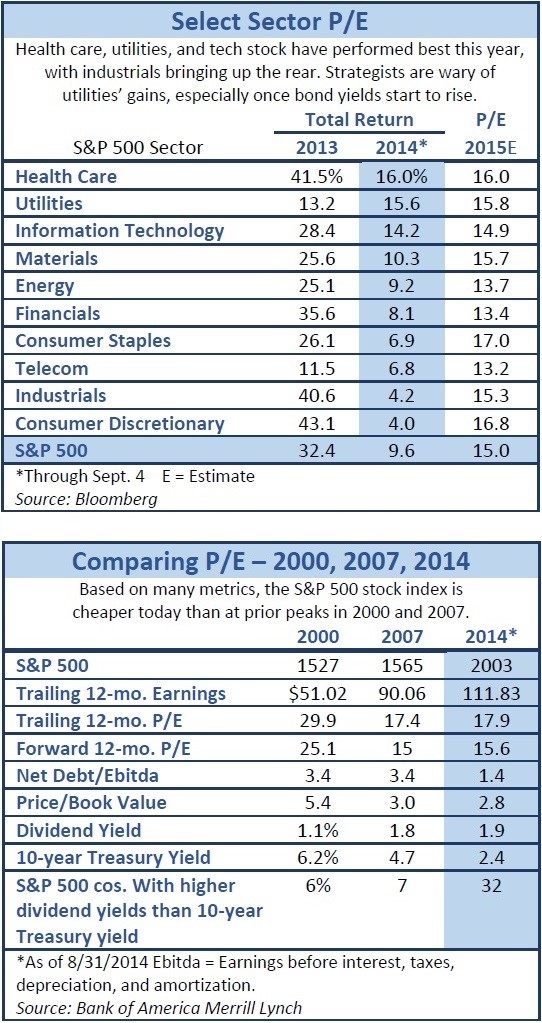
According to a Barron’s survey in September, P/E ratios were one of the main criteria used by 10 top analysts to measure equity valuations. They felt that with macroeconomic data improving and profitability broadening out, a case could be made that the market’s P/E ratios were extended but not outrageous. They viewed U.S. stocks as neither cheap nor expensive, considering the low level of interest rates. “Stocks offer less compelling value than a few years ago,” says Savita Subramanian, head of U.S. Equity and Quantitative Strategy at Bank of America Merrill Lynch. “But if anything, there’s an upside risk to my view.” (Source: Barron’s 9/1/2014)
Steven Auth, Chief Investment Officer of Federated Investors, is more bullish. “The U.S. economy is accelerating and so are earnings,” he said, adding that his market views have been right on for the past two years. (Source: Barron’s 9/1/2014)
However, John Campbell, a Harvard economist who collaborates with Robert Shiller (a Nobel laureate in economics who is also a noted P/E watcher) feels that based on today’s P/E measurements, stocks are overpriced. (Source: New York Times)
While the P/E ratio can be informative, you can see that not even the experts always agree on what it means. It is therefore important not to base a decision on this measure alone. When the denominator in this equation (earnings per share) shrinks, the actual numbers can change significantly.
STOCK BUYBACKS
Once again in the third quarter, corporate managements preferred to put their cash to work by purchasing their own stock. Reducing the number of outstanding shares raises the earnings per share. To the extent that corporate executives are compensated with stock, this can enhance their stakes. Many analysts presume that the decision to buy back stock is fueled by analyses that suggest that stock buybacks yield a better return than investments in expanding the businesses.
THE ECONOMY
Positive economic news during this quarter included the following:
- The U.S. labor market is improving at a faster rate, though gains remain slow enough to avoid provoking broad-based, late-cycle wage inflation. Year to date, the economy has added 1.6 million jobs—the 1.9% year-over-year increase in July was the fastest pace of growth since 2006.
(Source: Bureau of Labor Statistics)
- Core consumer inflation has slowed to 1.9% year over year. (Source: Fidelity.com)
- Personal consumption is still growing at a relatively modest 4% (nominal) year-over-year pace. (Source: Bureau of Economic Analysis, Haver Analytics)
In addition to this good news, of course, there were still some concerning factors. The main one was the housing sector, which remains in a soft patch, even though leading indicators are showing signs of slow improvement. Sales activity remains at historically weak levels and prices have flattened over the past three months. Construction starts and permit issuance remain at low levels, though they rose in July and remain in an upward trend. (Source: Core-Logic, Haver Analytics)
Although mortgage credit remains relatively tight during this quarter, banks reported the broadest rise in more than 20 years in their willingness to make residential loans during the second quarter.
GLOBAL OUTLOOK
Although differences vary wildly across the globe, overall economic developments outside the U.S. appear to be moving slowly and carefully.
Eurozone growth has idled due to GDP reductions in their two largest economies—Germany and France. However, analysts believe this might be a mid-cycle slowdown instead of the start of a new recession. Bank lending standards have eased up across the board and the European Central Bank has indicated a desire to help beyond the monetary stimulus plans already announced. The rate of growth is likely to remain low, with about 60% of the region’s economies experiencing expansion in their leading economic indicators during the past six months, down from 90% at the start of 2014.
Japan’s outlook remains ambiguous. Due to April’s tax hike, they recently underwent a worse-than-anticipated 19% annualized contraction in second quarter consumer spending. With the tax hike over, consumption should stay stable. Economic indicators have improved, but they still remain below the levels seen before the tax increase.
China, on the other hand, continues to benefit from their second quarter stimulus. However, leading indicators are exposing the diminishing returns that these policy decisions can provide and any return to expansive growth remains questionable. China’s property sector has been persistently plagued by falling housing prices and rising inventories and continues to be the largest near-term risk for economic and financial stability.
Across other developed markets, conditions vary drastically. Countries such as Indonesia and India seem to have benefited from the global stabilization after the interest rate shudder in 2013. Elections of perceived reformers have also seemed to add optimism back into their respective economies. Other emerging markets, such as Brazil, have been hindered by recessionary conditions. The weak global situation and diminishing commodity prices continue to challenge many developing countries. However, this significant variation among the world’s economies is still pushing the global business cycle into a slow upward trend.
INFLATION
The rate of inflation is something that is always monitored by the Fed and investment professionals. As mentioned earlier, inflation appears to be under control. However, it is important to remember that this number (which excludes food and energy) rose at its fastest pace in 15 months. (Source: Barron’s 6/23/2014)
Currently inflation isn’t high enough to cause much damage to the stock market, says Ned Davis of Ned Davis Research. He notes that since 1925, the S&P 500 has dropped 5% a year on average, when the inflation rate has exceeded the S&P500’s yield by more than 2.1 percentage points. While May’s 2.1% inflation rate was higher than the S&P 500’s 1.9% dividend yield, it’s in a range where shares have historically produced positive returns. (Source: Barron’s 6/23/2014)
Many investors are also concerned that inflation might start to decrease dramatically and actually cause a very unusual dilemma: deflation. This has already taken hold in many different European countries. The European Central Bank cut interest rates significantly and stimulated bank lending—moves that were specifically aimed at reversing this trend before other countries might encounter this problem. (Source: Wall Street Journal 6/6/2014)
CONCLUSION
Volatility seems to have returned to the equity markets and past 4th Quarters have seen their share of market swings. Analysts are focused on earnings, the Fed, the economy and stock valuations. However, individual investors still have to look at their own situations first. It is important to be cautious, but it is just as important to determine your own personal risk or “worry” level. That’s where we can help.
Now is good time to ask yourself:
- Has my risk tolerance changed?
- What are my investment cash flow needs for the next few years?
- What is a realistic return expectation for my portfolio?
Your answers to these questions will govern how we recommend investment vehicles for you to consider. We can help you determine which investments to avoid and how long to hold each of your investment categories before making major adjustments. For example, if your cash flow needs have changed for the next few years, you might consider different investments than someone who has limited to no cash flow needs.
We continually review economic, tax and investment issues and draw on that knowledge to offer direction and strategies to our clients.
We pride ourselves in offering:
- consistent and strong communication,
- a schedule of regular client meetings and
- continuing education for our team on the issues that affect our clients.
A good financial advisor team can help make your journey easier. Our goal is to understand our clients’ needs and then try to create a plan to address those needs. We continually monitor your portfolio. While we cannot control financial markets or interest rates, we keep a watchful eye on them. No one can predict the future with complete accuracy, so we keep the lines of communication open with our clients. Our primary objective is to take the emotions out of investing for our clients. We can discuss your specific situation at your next review meeting, or you can call to schedule an appointment. As always, we appreciate the opportunity to assist you in addressing your financial matters.
P.S. Under normal conditions, Fed tightening wouldn’t be too much of a worry. Since 1983, the Standard & Poor’s 500 Index has averaged a 4.4% gain during the 6 months before a hike and another 7.7% during the six months following it, according to Strategic Research Partners. The only problem: These aren’t normal times!
Note: The views stated in this letter are not necessarily the opinion of FSC Securities Corporation, and should not be construed, directly or indirectly, as an offer to buy or sell any securities mentioned herein. Investors should be aware that there are risks inherent in all investments, such as fluctuations in investment principal. With any investment vehicle, past performance is not a guarantee of future results. Material discussed herewith is meant for general illustration and/or informational purposes only, please note that individual situations can vary. Therefore, the information should be relied upon when coordinated with individual professional advice. This material contains forward looking statements and projections. There are no guarantees that these results will be achieved. There is no guarantee that a diversified portfolio will outperform a non-diversified portfolio in any given market environment.
Due to volatility within the markets mentioned, opinions are subject to change without notice. Information is based on sources believed to be reliable; however, their accuracy or completeness cannot be guaranteed. The P/E ratio (price to earnings ratio is a measure of the price paid for a share relative to the annual net income or profit earned by the firm per share. It is a financial ratio used for valuation: a higher P/E ratio means that investors are paying more for each unit of net income, so the stock is more expensive compared to one with lower P/E ratio. All indices referenced are unmanaged and cannot be invested into directly. Unmanaged index returns do not reflect fees, expenses, or sales charges. Index performance is not indicative of the performance of any investment. Past performance is no guarantee of future results. The Standard and Poors 500 index is a capitalization weighted index of 500 stocks designed to measure performance of the broad domestic economy. The Dow Jones Industrial average is comprised of 30 stocks that are major factors in their industries and widely held by individuals and institutional investors. In general, the bond market is volatile, bond prices rise when interest rates fall and vice versa. This effect is usually pronounced for longer-term securities. Any fixed income security sold or redeemed prior to maturity may be subject to a substantial gain or loss.
Sources: Barron’s; New York Times; Core-Logic-Haver Analytics; Bureau of Economic Analysis-Haver Analytics; Fidelity; Bureau of Labor Statistics; Wall Street Journal; HSH.com; Contents © 2014 Academy of Preferred Financial Advisors
Forbes Lists Naples, FL at Top of Best Cities for Future Job Growth
 Economic Growth has now returned to the Sunshine State… Naples, FL was recently ranked as the #1 city in the United States for job growth over the next three years. Austin, Texas finished second and two other Florida cities also ranked in the Top 10 (Cape Coral and Port St. Lucie). Expected Naples job growth is projected to be about 4.1% annually over the next three years- primarily in the healthcare, retail, leisure, and hospitality sectors.
Economic Growth has now returned to the Sunshine State… Naples, FL was recently ranked as the #1 city in the United States for job growth over the next three years. Austin, Texas finished second and two other Florida cities also ranked in the Top 10 (Cape Coral and Port St. Lucie). Expected Naples job growth is projected to be about 4.1% annually over the next three years- primarily in the healthcare, retail, leisure, and hospitality sectors.
According to a recent article published on www.Forbes.com, Florida added retail jobs at the fastest rate of any state in 2013 and Naples was the top ranked market in Florida. The study was conducted by Moody’s Analytics where they looked at the 200 largest metro areas in the country and their projected growth rates through the year 2016.
When the financial/real estate crisis hit the country back in 2007-2008, home prices in Florida nosedived, foreclosures and short-sales climbed, and unemployment skyrocketed to 11.4% across the state of Florida. Naples unemployment peaked at 12.2% in January 2010, it has since dropped to 5.4% in June of 2014. A majority of the growth is attributed to stock market gains which is fueling spending on construction, tourism, and consumer goods in the area.
Other cities that made the Top 10 list included the Texas cities of Dallas, Houston, San Antonio, and McAllen- along with Greeley, CO and Raleigh, NC. All are expected to have annual job growth of at least 3.5%.1
1“Naples, Austin Head List of Best Cities for Job Growth”, www.Forbes.com, by Kurt Badenhausen, July 23, 2014
Listed entities are not affiliated with FSC Securities Corporation.
CAS Rochester – Annual Client Night with the Red Wings
 The CAS Rochester office rallied clients numbering 527 all told to come out and cheer on the hometown team on Friday, August 15, 2014!
The CAS Rochester office rallied clients numbering 527 all told to come out and cheer on the hometown team on Friday, August 15, 2014!
CAS clients filled two sections of the stadium to watch their very own Rochester Red Wings (International League North Triple-A affiliate of the Minnesota Twins) battle their upstate rival, the Syracuse Chiefs (International League North Triple-A affiliate of the Washington Nationals). The teams were in a dead heat leading into the game.
A ballpark-fare picnic was offered before the first pitch flew at 7:15. The entire park was packed with devoted fans. A guest appearance by the Navy Blue Angels, in town for the weekend for a scheduled air show, was an added bonus.
The Red Wings rallied early on but lost ground as the crisp August air took hold. It was an event the CAS Rochester clients will relish until they turn out to cheer on the home team again next season. Wait ‘til next year for more!
Use Your Annuity to Pay for Long-Term Care Insurance
The cost of long-term care can quickly deplete your savings and affect the quality of life for you and your family. Long-term care insurance allows you to share that cost with an insurance company. But premiums for long-term care insurance can be expensive, and cash or income to cover those premiums may not be readily available. One option is to exchange your annuity contract for a long-term care insurance policy.
Section 1035 exchange
Generally, withdrawals from a nonqualified deferred annuity (premiums paid with after-tax dollars) are considered to come first from earnings, then from your investment (premiums paid) in the contract. The earnings portion of the withdrawal is treated as income to the annuity owner, subject to ordinary income taxes. IRC Section 1035 allows you to exchange one annuity for another without any immediate tax consequences, as long as certain requirements are met. However, prior to 2010, an annuity couldn’t be exchanged for a long-term care insurance policy on a tax-free basis. But the Pension Protection Act (PPA) changed that and, as of January 1, 2010, both life insurance and annuities may be exchanged, tax free, for qualified long-term care insurance.

Generally, to be considered a tax-free exchange rather than a taxable surrender, you cannot receive the annuity proceeds directly–the proceeds from the annuity must be paid directly to the long-term care insurance company. Also, Section 1035 applies only if both the annuity contract and the long-term care insurance policy are owned by the same person or persons.
Conditions for tax-free exchange
In order for the transfer of the annuity to the long-term care insurance policy to be treated as a tax-free exchange, certain conditions must be met:
- The annuity must be nonqualified, meaning it cannot be part of an employer-sponsored retirement plan. For example, a tax-sheltered annuity or an annuity used to fund an IRA would not qualify for tax-free exchange treatment.
- The long-term care insurance policy must meet the requirements of the Health Insurance Portability and Accountability Act (HIPPA) and IRS criteria. Generally, the long-term care insurance policy must provide coverage only for qualified long-term care services; it must be guaranteed renewable; it cannot have a cash surrender value; refunds or dividends can only be used to reduce future premiums; and policy benefits cannot pay for expenses covered by Medicare (except where Medicare is a secondary payee).
- The exchange must be made directly from the annuity issuer to the long-term care insurance company. You will not receive tax-free treatment if you withdraw funds from the annuity directly, then use them to pay the long-term care insurance premium.
Presuming these criteria are met, exchanging an annuity for a long-term care policy can be done in one of two ways: a full transfer of the entire cash surrender value of the annuity in exchange for the long-term care insurance policy; or partial exchanges of the annuity’s cash value for the long-term care policy. Not all insurance companies allow long-term care policies to be funded with a single, lump-sum payment, so the more common approach may be to pay long-term care insurance premiums through several partial exchanges from the annuity.
Potential tax advantages
Exchanging your nonqualified deferred annuity for a long-term care insurance policy may have several tax-related advantages. You can use annuity earnings to pay for long-term care insurance without paying income tax on those earnings. This allows you to use otherwise taxable annuity earnings in a more tax-efficient manner.
According to the IRS, Section 1035 exchanges from a nonqualified annuity to pay for tax-qualified long-term care insurance are pro-rated based on the comparative percentages of principal and earnings in the annuity. For example, say you have a nonqualified annuity worth $100,000, which includes your premium of $50,000, plus earnings worth $50,000, and you haven’t taken any previous withdrawals. You direct the annuity issuer to send $2,500 to the long-term care insurance carrier as a partial exchange to pay for insurance premiums. Your annuity cash value is reduced by $2,500, but half of that amount ($1,250) comes from earnings. As a result, not only have you withdrawn annuity earnings ($1,250) without paying taxes on them, but you have further reduced the taxable portion of your annuity by $1,250. By withdrawing earnings from your annuity to pay for long-term care insurance, you could reduce the taxable portion of your annuity, which can be important if you surrender the annuity later.
Another advantage relates to the long-term care insurance policy. Generally, a qualified long-term care insurance policy is treated as an accident and health insurance contract, and the benefits are typically treated as tax free, subject to certain limits. In this way, you may be able to use tax-free annuity earnings to pay for tax-free long-term care benefits.
Other possible benefits

Generally, IRC Section 1035 allows tax-free exchanges in the following circumstances:
•An annuity contract for an annuity contract
•A life insurance policy for an annuity contract
•An endowment contract for an annuity contract
•A life insurance policy for a life insurance contract
•A life insurance policy for an endowment contract
•An endowment policy for an endowment contract (with special requirements)
•A life insurance policy, endowment contract, annuity, or qualified long-term care policy for a qualified long-term care contract
Aside from the favorable tax treatment, there may be other benefits as well.
- Using an annuity to pay for long-term care insurance may lessen the need to tap other savings or income to pay for premiums.
- You may still use any remaining cash surrender value of the annuity for other income needs or expenses.
- Exchanging the annuity for long-term care insurance may better meet your current needs, financial situation, and preferences.
Some potential disadvantages
There are also some potential disadvantages to exchanging an annuity for long-term care insurance.
- Annuity surrender charges might be incurred on the exchange of the annuity, thus reducing the annuity’s value.
- Reducing the annuity’s value to pay for long-term care insurance premiums may reduce your ability to use the annuity to provide income needed in the future.
- Some nonqualified deferred annuities might not be eligible for a partial Section 1035 exchange because the annuity contracts may not allow annuity payments to be made to other than the annuity owner (e.g., annuity payments cannot be assigned to another payee).
- If you exchange the annuity for a long-term care insurance policy, your survivors won’t have the annuity’s cash value for income or savings that otherwise would have been available at your death.
- Generally, premiums for qualified long-term care insurance are deductible as qualified medical expenses subject to certain restrictions. The tax savings of using a tax-free Section 1035 exchange needs to be compared to available federal or state income tax deductions for long-term care insurance premiums. Depending on your situation, it might be more beneficial to deduct premiums and include annuity earnings as taxable income.
Frequently asked questions
If I am the sole owner of the annuity, can I exchange it for a long-term care insurance policy jointly owned by my spouse and me?
Generally, no, because the owners of both the annuity and the long-term care insurance policy must be the same. However, you may be able to change the ownership of your annuity to include your spouse. While changing ownership of an annuity is generally treated as a taxable event to the extent of gain (earnings) in the annuity, ownership changes between spouses are typically tax free, but be sure to consult your tax or financial professional before making ownership changes to your annuity.
I’m receiving payments from a non-qualified immediate annuity. Can I exchange these payments for long-term care insurance?
You may be able to assign the payments directly to the long-term care insurance company as a 1035 exchange, but the annuity payee must be the long-term care insurance company–if you’re listed as the payee, payments will not receive tax-free treatment. Also, be aware that if long-term care insurance premiums increase, the annuity payments may not be sufficient to cover the cost of the long-term care insurance premiums. Also, if the annuity payment exceeds the insurance premium, you may be able to split the annuity payment, where an amount equal to the insurance premium is sent to the long-term care insurance company and the balance of the annuity payment is sent to you, but this would be at the discretion of the annuity issuer.
Can I use more than one annuity to pay for long-term care insurance?
Generally, yes, because funds from one or more non-qualified annuities can be exchanged for a long-term care insurance policy.


